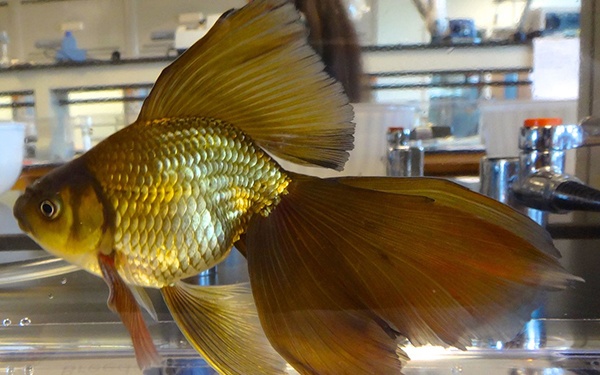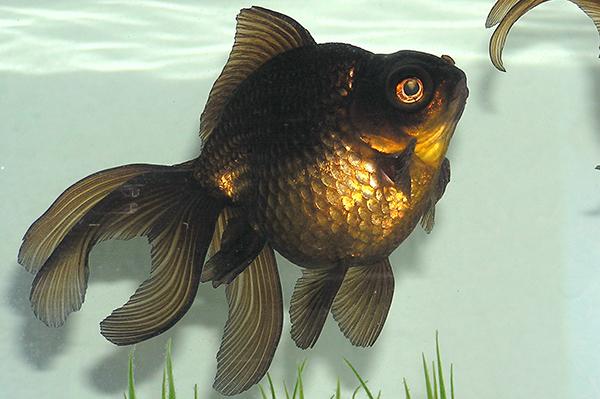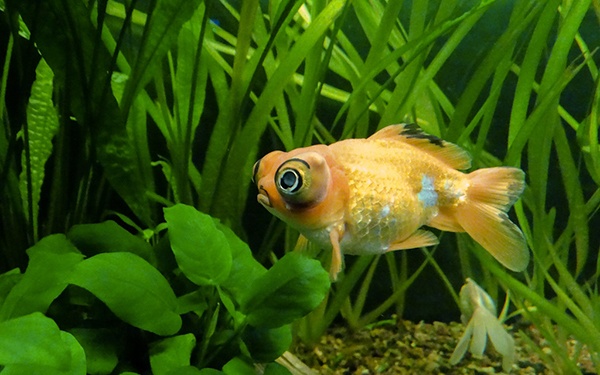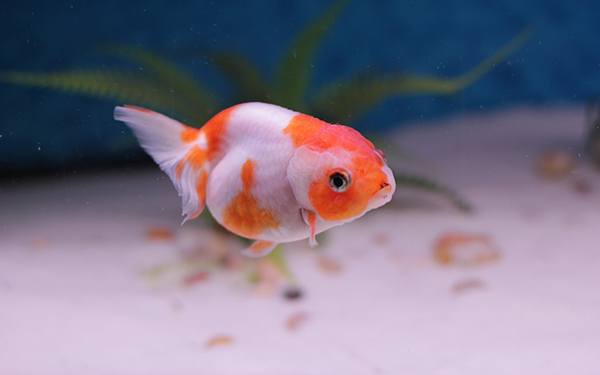Curious about the different types of goldfish? Here’s our handy guide to the best of them!
Keeping goldfish can be great fun.
They’re affordable and easy to maintain, and they make practical pets for children or people who haven’t got much time on their hands.
Did you know that watching goldfish can help reduce anxiety, lower blood pressure, and even increase your appetite?
Colorful enough to brighten up any room, there are myriad varieties of goldfish in a wide varieties of beautiful forms and patterns, and they can have surprisingly distinctive characters too.
But which goldfish will you choose for your tank? Let’s take a look at some of the coolest goldfish around…
Contents
Hardy Goldfish vs Fancy Goldfish
Goldfish fall into two main categories — hardy and fancy — both of which are freshwater fish that can tolerate cooler water temperatures.
Hardy goldfish are tougher and can be kept in outdoor ponds as well as inside in tanks.
They tend to be slim bodied in appearance, are strong and less prone to disease, and are strong swimmers. Hardy goldfish also have big appetites which when combined with their speedy swimming style can often mean that slow moving fancy goldfish are left with little or nothing to eat, or injured, so it may not be advisable to keep the two types together in a small space.
Fancy goldfish are also much more sensitive to poor water conditions, but they are also a glamorous addition to a freshwater aquarium, and can live a long time when cared for correctly.
Depending on the variety they can have long, double fins, protruding eyes, bubble pouches beneath the eyes, calico colouring, or other interesting physical features.
They are extremely gentle, peaceful fish which are a pleasure to watch.
Types of Goldfish
Fantail

The fantail is one of the hardiest fancy varieties, and features an egg shaped body and a split caudal fin which fans out behind them.
Fantails are typically found in orange, yellow, or calico colours, and are easy to care for — and can even often live outdoors as pond fish.
They are a very friendly and docile fish, although as medium strength swimmers they should be kept with other goldfish varieties which are similarly competent swimmers rather than slower, more fragile varieties.
If given enough space, fantail goldfish can grow quite large — averaging at around 6 to 8 inches in length — but to be healthy they do require a minimum of 10 to 20 gallons of water per fish.
Even though fantails are a hardy fancy fish, they can still be prone to swim bladder issues, so it’s important that they eat a balanced diet.
Ryukin

The short bodied Ryukin were developed from the common fantail and can be easily identified by the large hump behind their head which gives their back and face a pointed appearance.
Ryukin come in all kinds of colours, including orange, black, white, and calico.
They are relatively hardy and easy to care for, and are capable of living outside in cooler temperatures or in poorer quality water.
The average size of an adult Ryukin is 6 inches, although they have been known to grow to as long as 10 inches and live for more than 20 years if well cared for.
Ryukin are friendly and social, and integrate well with other goldfish, although they will out compete more fragile varieties such as Bubble Eyes when it comes to food.
It is important not to overfeed fancy fish such as the Ryukin, but ensure that they are provided with a good quality fish food and something healthy to graze on such as lightly steamed greens.
Common Goldfish

The good old Common Goldfish is a fantastic fish for beginners — and far from boring.
Being a very hardy fish they can handle a variety of aquarium or pond conditions, and are not picky about food.
As with all fancy goldfish, the ideal preferred water temperature for the common goldfish is around 18°C to 22° C, however they can tolerate temperatures much warmer than that all the way down to a few degrees above freezing.
This sociable and cheerful goldfish was developed from the ancient Chinese breeding Carp, and today has evolved from its original silvery colour into various vibrant orange, yellow, red, and white colours.
Slender and long bodied, the Common Goldfish is well proportioned and fast and agile, and can be very competitive when it comes to feeding time. They are also prolific breeders.
Provided that they have the space, the Common Goldfish will keep growing up to a length of 12 inches.
The best food for these fish is a staple diet of pellets, flakes or live foods, plus plant material for grazing.
Comet

Comets are very similar to the Common Goldfish, albeit with one major difference — their tail.
The tail of a Comet is significantly longer than that of the Common Goldfish, and has pointed tips.
Comets exist in many different colour combinations of red, white, yellow, and chocolate.
Given the right care, this hardy breed can grow to over 12 inches in length and live for up to 40 years.
Also like their Common cousins, Comets are an active community fish, excellent swimmers, and can be kept either indoors or outdoors.
This slim bodied goldfish breeds at the drop of a hat, but requires a minimum of 40 gallons of water per fish to live healthily and comfortably.
Comets mix best with other slim bodied goldfish rather than more fragile fancy types.
Shubunkin

Another athletic, hardy goldfish is the Shubunkin.
Shubunkins are very similar to the Common Goldfish and Comet goldfish in appearance, with the main difference being that they have a calico pattern in a mix of colours such as white, blue, orange, yellow, black, and metallic.
As a general rule, the more blue colouring the fish has, the more expensive it will be.
Shubunkins also have long fins and tails, which although very beautiful may pose some potential health problems including ripping and scarring or even fin rot.
The bigger the fish, the greater the likelihood of such an issue arising, and when you consider that Shubunkins can grow up to 14 inches in length it can be a good idea to try and restrict their size by giving them less space in which to grow.
The typical lifespan of a Shubunkin is 10 to 15 years.
Oranda

This popular egg shaped fancy goldfish has a short, stubby body and an ornamental fleshy growth on the top of its head.
This growth is known as a wen, and is make up of nerveless tissue which can often also grow around the face and gills and gives the Oranda a cute, puppy like facial appearance.
With age, the wen can become very large and may obscure the fish’s vision, in which case the fish needs to be sedated and the wen trimmed. Thankfully this doesn’t hurt the fish in any way, and afterwards it can rejoin its tank mates and go about life as usual. They are also prone to swim bladder disorder.
Orandas can have one of several different tail types including ribbontail, fantail and broadtail, and come in a variety of colour combinations of red, white, calico, silver, black, and more.
For a fancy goldfish Orandas can grow to a very large size of around 12 inches, and lives to an average of 5 to 10 years but with the possibility to live for far longer if kept correctly.
They are very gentle fish who love being part of a community, but need at least 10 to 20 gallons of water per fish to stay healthy.
Water quality needs to be clean to prevent the wen becoming infected.
Orandas tend to do best in a community with other gentle, slower swimming fancy fish such as Lionheads, Black Moor, or Ranchu.
Pompom

Also known as the Velvet Ball in China, the Pompom goldfish has fleshy growths resembling a cheerleader’s pompoms above each of its nostrils. They may or may not have a dorsal fin.
The Pompom’s body shape is like that of the Oranda, being very short and egg shaped.
The nasal pom poms won’t develop fully until the fish is mature.
Capable of achieving 6 to 8 inches in length, Pompoms are available in many different colours, including chocolate, orange, yellow, red, silver, and white.
The distinctive nasal pompoms of this fancy goldfish variety are delicate, so in order to protect them it’s necessary to ensure that there are no sharp edges in the tank, and that your Pompom is placed in a community with other slow moving, friendly fish.
Lionhead
Named for their full facial wen which resembles a lion’s mane when fully developed, Lionhead goldfish have a cute appearance and a sweet nature.
They have an egg shaped body and a relatively flat back which lacks a dorsal fin. Lionheads have short, double fins, although a rare longtail variety does exist.
They come in either single colours including orange, black, and red, or in bi-colour or tri-colour combinations, or calico colours.
These somewhat hardy fancy goldfish can sometimes survive well outdoors in a pond environment, but may also experience restricted vision if their wen grows too large and covers their eyes.
They can achieve up to 8 inches in length and live an average of 5 to 10 years.
Due to the fact that Lionheads are slow swimmers they are best kept with other similar slow moving goldfish varieties.
Bubble Eye

Yep, you’ve guessed it, the outstanding feature of the Bubble Eye are the large, bubble like sacks under each eye.
These sacks are filled with fluid which keeps them inflated, but these sacks are also very delicate — particularly in the case of older fish — and can be easily damaged or popped.
Great care must be taken to ensure the aquarium environment is safe and that the water filter is not too strong.
If they are taken good care of however, Bubble Eyes can live just as long as other fancy goldfish, but tend to stay small, growing no bigger than around 6 inches.
Due to their delicate nature, they are best kept exclusively with other Bubble Eyes, or maybe Celestial Eyed goldfish or other slow swimmers that won’t put up stiff competition for food.
Veiltail

Undeniably elegant, the gorgeous Veiltail has a rounded egg shaped body with a long, broad, flowing tail which should attain twice the length of the fish’s body once fully developed, giving it an angelic appearance.
The drawback to such luxurious fins is that they can easily get torn or damaged, or nibbled at by other tank mates.
Help keep your Veiltail’s fins in top condition by ensuring that water quality in the aquarium is good, that there are no sharp edges and that any tank decorations are fish fin friendly.
It’s also important to feed Veiltails a healthy diet with a combination of nutritious pellets and fresh, leafy veg.
These beautiful fish are available in a range of colours and scale types, including solid red, calico, and pearlescent.
The length of the Veiltail’s fins can weigh them down, making them slow swimmer.
Placed in a small community with other delicate, slow swimming fancy goldfish, Veiltails should do well. They are capable of reaching up to 12 inches long, including that impressive tail.
Black Moor

Existing only in classic black colour, Black Moors have a soft, velvety appearance, and upon reaching adulthood, develop protruding telescopic eyes.
They have a rounded, chubby body shape and can reach lengths of up to 8 inches on average.
While Black Moors are certainly a handsome fancy goldfish variety, they cannot see well and therefore need to be placed in a tank with similarly slow moving or vision impaired fish such as Telescope Eyed goldfish or Lionheads, as it can take them time to locate their food.
Also, their boggly eyes and flowing fins can suffer damage from dangerous objects within the tank, or bullying by other fish.
Despite their visual handicap, Black Moors remain fairly hardy.
Telescope Eye

Much like Black Moors, Telescope Eyed goldfish have large, protruding eyes but very poor vision.
This means they need a bit of TLC to ensure that no harm comes to them from bumping into painful or damaging objects or by being bullied by other fish.
Unlike Black Moors, Telescopes exist in a host of different colours such as a red / white mix, plain red, black and white — known as pandas — and calico.
The amazing yet delicate eyes of these big eyed beauties can be either flat, domed, or rounded.
If kept correctly this fish should reach a size of 6 to 8 inches, and live for an average of 10 to 15 years.
As is the case with Black Moors, Telescope Eyed fancy goldfish should be kept with equally sweet natured, slow swimming varieties of other goldfish.
Which do you think is the best type of goldfish?


